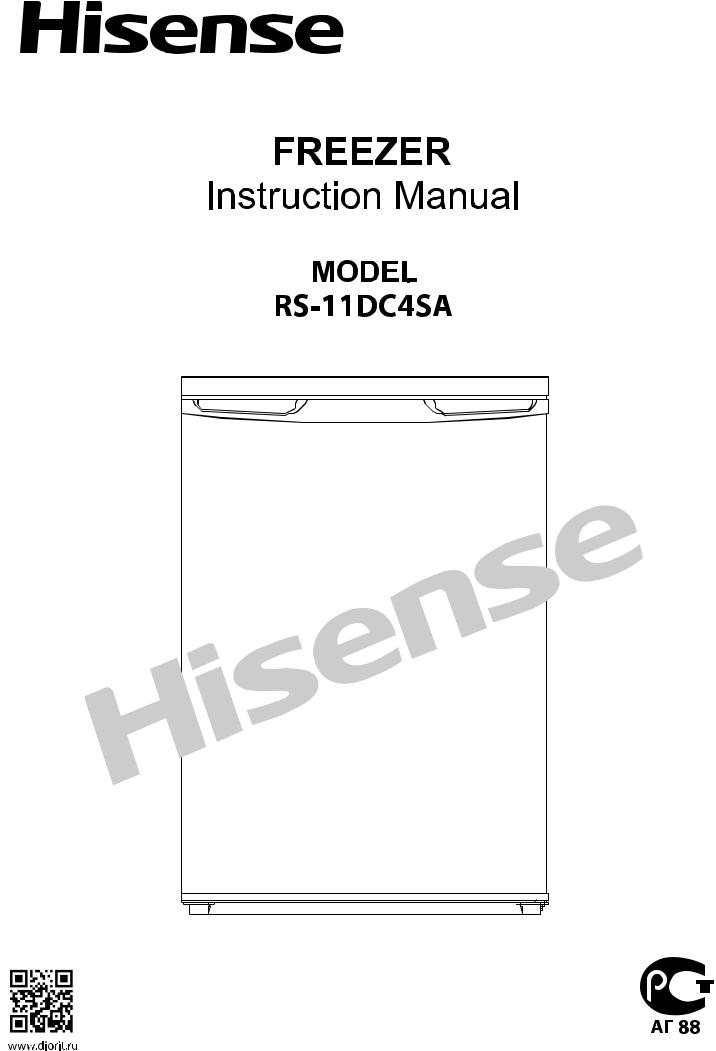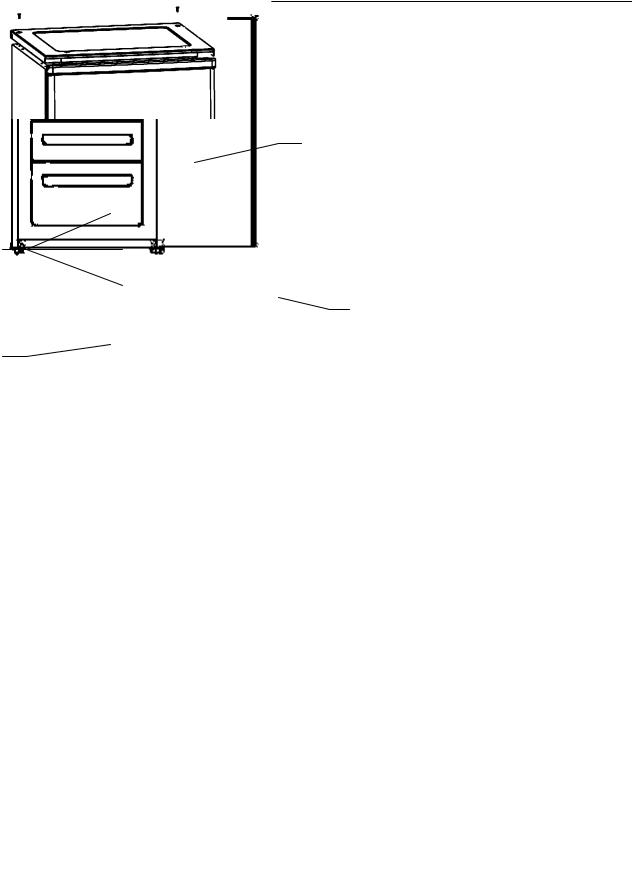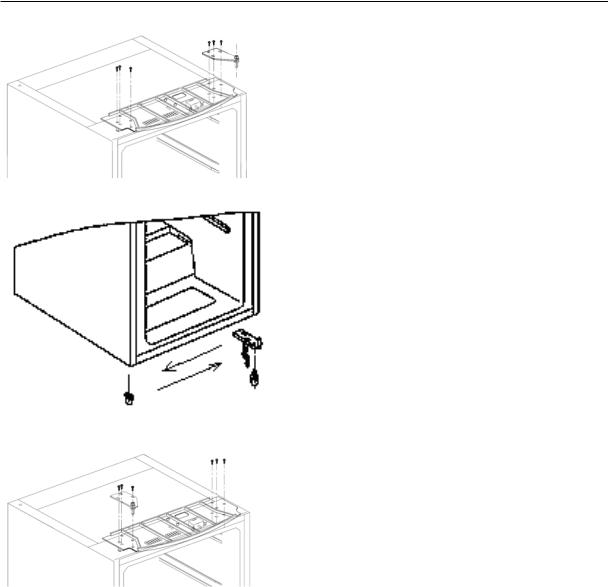Hisense RS-11DC4SA User Manual [ru]


Dear customer,
Before placing your new refrigerator/freezer into operation please read these operating instructions carefully. They contain important information for safe use, for installation and for care of the appliance.
Please keep these operating instructions for future reference. Pass them on to possible new owners of the appliance.
Notes which are important for your safety or for the proper functioning of the appliance are stressed with a warning triangle and/or with signal words (Warning!, Caution!, Important! ). Please observe the following carefully.
Supplementary information regarding operation and practical applications of the appliance appear after this symbol.
Tips and notes concerning economical and environmentally sound use of the appliance
are marked with the cloverleaf.
The operating instructions contain instructions for the correction of possible malfunctions by the user in the section “Trouble shooting” . If these instructions should not be sufficient, contact your local Service Force Center.
Printed on paper manufactured with environmentally sound processes he who thinks
ecologically acts accordingly...

Contents |
|
Important Safety Instruction ------------------------------------------------------------------ |
page 3 |
Remove transport packaging --------------------------------------------------------------- |
page 4 |
Installation ---------------------------------------------------------------------------------------- |
page 5 |
Positioning ---------------------------------------------------------------------------------------- |
page 5 |
Description of the appliance ----------------------------------------------------------------- |
page 6 |
View of the appliance -------------------------------------------------------------------------- |
page 6 |
Reversing the door ----------------------------------------------------------------------------- |
page 6 |
Starting up and temperature regulation --------------------------------------------------- |
page 7 |
Interior Accessories ---------------------------------------------------------------------------- |
page 8 |
Defrosting ---------------------------------------------------------------------------------------- |
page 8 |
Cleaning and Care ----------------------------------------------------------------------------- |
page 9 |
Energy Saving Tips ---------------------------------------------------------------------------- |
page 9 |
Trouble shooting -------------------------------------------------------------------------------- |
page 9 |
Noises during Operation --------------------------------------------------------------------- |
page 10 |
Regulations, Standards, Guidelines ------------------------------------------------------- |
page 11 |
Disposal of the appliance -------------------------------------------------------------------- |
page 11 |
1

Important safety instructions
These warnings are provided in the interests of your safety. Ensure you fully understand them before installing or using the appliance.
Your safety is paramount importance. If you are unsure about the meaning of these warnings contact the Customer Care Department for assistance. Intended use
This appliance is intended to be used in household and similar applications such as
–staff kitchen areas in shops, offices and other working environments;
–farm houses and by clients in hotels, motels and other residential type environments;
–bed and breakfast type environments;
–catering and similar non-retail applications.
It is suitable for the storage of food at low temperature. If the appliance is used for purposes other than those intended or used incorrectly, no liability can be accepted by the manufacturer for any damage that may be caused.
Alterations or changes to the refrigerator are not permitted for reasons of safety.
If you use the refrigerator in a commercial application or for purposes other than the cooling of foods, the manufacturer accepts no liability for any damages that may occur.
Prior to initial start-up
Check the appliance for transport damage. Under no circumstances should a damaged appliance be plugged in. In the event of damage, please contact your supplier.
Refrigerant
The refrigerant isobutene (R600a) is contained within the refrigerant circuit of the appliance, a natural gas with a high level of environmental compatibility, which is nevertheless flammable. During transportation and installation of the appliance, ensure that none of the components of the refrigerant circuit becomes damaged.
The refrigerant (R600a) is flammable.
Caution: risk of fire
If the refrigerant circuit should become damaged:
zAvoid open flames and sources of ignition.
zThoroughly ventilate the room in which the appliance is situated.
The instructions shall include the warnings:
WARNING!—Keep ventilation openings, in the appliance enclosure or in the built-in
structure, clear of obstruction.
WARNING!—Do not use mechanical devices or other means to accelerate the defrosting
2

process, other than those recommended by the manufacturer.
WARNING!—Do not damage the refrigerant circuit.
WARNING!—Do not use electrical appliances inside the food storage compartments of the appliance, unless they are of the type recommended by the manufacturer.
WARNING! —Do not store explosive substances such as aerosol cans with a flammable propellant in this appliance.
WARNING!—This appliance is not intended for use by persons (including children) with reduced physical, sensory or mental capabilities, or lack of experience and knowledge, unless they have been given supervision or instruction concerning use of the appliance by a person responsible for their safety
WARNING!—Young children should be supervised to ensure that they do not play with
the appliance
WARNING!—If the supply cord is damaged, it must be replaced by the manufacturer, its service agent or similarly qualified persons in order to avoid a hazard.
WARNING!—When disposing of the appliance, do so only at an authorized waste disposal centre. Do not expose to flame.
WARNING!—Please keep the appliance away from substance, which can cause ignition. WARNING!--- Before obtaining access to terminals, all supply circuits must be
disconnected.
WARNING!--- Please remove all the doors before you dispose your refrigerator. WARNING!--- The fridge is only applied with power supply of single phase alternating current of 220~240V/50Hz. If fluctuation of voltage in the district of user is so large that the voltage exceeds the above scope, for safety sake, be sure to apply A.C. Automatic voltage regulator of more than 350W to the fridge. The fridge must employ a special power socket instead of common one with other electric appliances. Its plug must match the socket with ground wire.
Safety of children
Packaging (e.g. wraps, polystyrene) can be dangerous for children.
There is a risk of suffocation! Keep packaging material away from children!
Make old appliances unusable prior to disposal. Pull out the mains plug, cut off the mains cable, break or remove spring or bolt catches, if fitted. By doing this you ensure that children cannot lock themselves in the appliance when playing (there is risk of suffocation!) or get themselves into other dangerous situations.
Often children cannot recognize the hazards present in household appliances. It is therefore important that you ensure adequate supervision and never let children play with the appliance!
Daily Operation
Containers with flammable gases or liquids can leak at low temperatures. There is a risk of an explosion! Do not store any containers with flammable materials such as spray cans, fire extinguisher refill cartridges etc in the refrigerator and/or freezer.
3

Do not operate any electrical appliances in the freezer (e.g. electric ice cream makers, mixers etc.).
Before cleaning the appliance, always switch off the appliance and unplug it, or pull the house fuse or switch off the circuit breaker.
When unplugging always pull the plug from the mains socket, do not pull on the cable.
In case of malfunction
If a malfunction occurs on the appliance, please look first in the Trouble shooting section of these instructions. If the information given there does not help, please do not perform any further repairs yourself.
Under no circumstance should you attempt to repair the appliance yourself. Repairs carried out by inexperienced persons may cause injury or serious malfunctioning. Contact your local Service Force Center.
Remove transport packaging
The appliance and the interior fittings are protected for transportation. Pull off the adhesive tape on the left and right side of the door. You can remove any remnants of adhesive using white spirit. Remove all adhesive tape and packing pieces from the interior of the appliance.
Installation
Installation Location
Before installing, carefully read the instruction in order to avoid a certain number of problems.
Positioning
Position the appliance away from sources of heat such as stoves, radiators, direct sunlight etc. Maximum performance and safety are guaranteed by maintaining the correct indoor temperature for the class of unit concerned, as specified on the rating plate. This application perform well from N to ST. The Appliance may not work properly if it is left for a longer period at a temperature above or below the indicated range.
IMPORTANT! -There is a need of good ventilation around the fridge for easy dissipation of heat, high efficiency of refrigeration and low power consumption. For this purpose, sufficient clear space should be available around the fridge. It is advisable for there to be 75mm separating the back of the fridge to the wall, at least 100mm of space at its two sides, height of over 100mm from its top and a clear space upfront to allow the doors to open 160 .
Climate classification |
Ambient temperature |
SN |
10~32°C |
|
|
N |
16~32°C |
ST |
16~38°C |
T |
16~43°C |
|
|
4

Appliances must not be exposed to rain. Sufficient air must be allowed to circulate in the lower rear section of appliances, as poor air circulation can affect performance. Built-in appliances should be positioned away from heat sources such as heaters and direct sunlight.
5

Description of the appliance
View of the appliance
1.Temperature Regulator
2.Upper Drawer in freezer |
|
3.Lower Drawer in freezer |
|
4.Door |
1 |
|
2
4
3
Reversing the door
The side at which the door opens can be changed from the right side (as supplied) to the left side, if the installation site requires.
Before you start lay the refrigerator on it’s back in order to gain access to the base,you should rest it on soft foam packaging or similar material to avoid damaging the cooling pipes at the rear of the refrigerator.
1. Stand the refrigerator, use a flat bladed screw driver to remove the 2 screw covers at the rear of the refrigerator lid.
2. Unscrew and lift the lid from the rear and remove it, then lift the door and place it on a padded surface to prevent it scratched.
3.Remove the upper hinge core, transfer it to left side and tighten securely, then put it in a safe place
6

4. Remove both adjustable feet and remove the bottom hinge bracket by unscrewing the bolts.
5. Replace the lid by fitting the upper hinge core into the upper door’s hole, securing it with the 2 screws. Replace the screw covers.
Warning!
When changing the side at which the door opens, the appliance must not be connected to the mains. Remove plug from the mains beforehand.
Starting up and temperature regulation
Insert the plug of the connection lead into the plug socket with protective earth contact. The temperature selector knob is located on the top of the refrigerator compartment.
Thermostat Control
The thermostat control situated in the control panel regulates the temperature of the freezer compartment.
z |
Position |
COLD |
–Cold. |
z |
Position |
MID -Colder. normally, setting at this position. |
|
z |
Position |
COLDER |
–Coldest. |
The temperature will be affected by:
Room temperature;
How often the door is opened;
How much food is stored;
Position of the appliance.
Important!
7

Normally we advise you select setting of Normal, if you want the temperature warmer or colder please turn the knob to lower or higher setting accordingly.
When you turn the knob to lower which can lead to the more energy efficiency. Otherwise, it would result the energy-consuming.
Important!
High ambient temperatures (e.g. on hot summer days) and a cold setting on the temperature regulator (position Super) can cause the compressor to run continuously or even non-stop!
Reason: when the ambient temperature is high, the compressor must run continuously to maintain the low temperature in the appliance.
Interior accessories
IMPORTANT! – in order to make the most of the volume of the fresh food storage compartment and frozen-food storage compartment, the user can removed one or more drawers, out of the appliance, according to your daily use.
Tips:
Food in the refrigerator should always be covered or packaged, to prevent drying and tainting of other food.
The following are suited for packaging: Polyethylene airtight bags and wraps, Plastic containers with lids;
Special plastic covers with elastic, Aluminium foil.
Defrosting Why defrosting
Water contained in food or getting into air inside the fridge be opening doors may form a layer pf frost inside. It will weaken the refrigeration when the frost is thick. While it is more than 10mm thick, you should defrost.
Defrosting in frozen-food storage compartment
Defrosting in freezer chamber is operated manually. Before defrosting, pull out the mains plug (where the compressor will stop working) ,then take the food out; take the ice tray and drawers out, and leave the door of the refrigerator open until ice and frost dissolve thoroughly and accumulation at the bottom of the freezer chamber. Wipe off the water with soft cloth. In the case of speeding up the process of defrosting, you may put a bowl of warm water (about 50 ) into the freezer chamber, and scrape away the ice and frost with a defrosting spatula. After doing so, be sure to set the knob of the temperature regulator to the original position.
It is not advisable to heat the freezer chamber directly with hot water or hair dryer while defrosting to avoid deformation of the inner case.
It is also not advisable to scrape off ice and frost or separate food from the containers which have been congealed together with the food with sharp tools or wooden bars, so as not to damage the inner casing or the surface of the evaporator.
Important!
The fridge should be defrosted at least every one month. During the using process, if the door was opened frequently or using the appliance in the extreme humidity, we advise the user to defrost every two weeks. .
If the appliance is not going to be used for an extended period:
Remove all refrigerated packages.
Remove the mains plug or switch off or disconnect the electricity supply.
Clean thoroughly (see section: Cleaning and Care)
Leave the door open to avoid the build up of odors.
8
